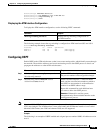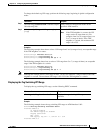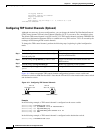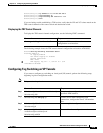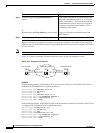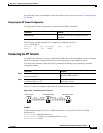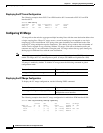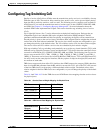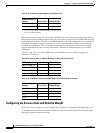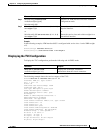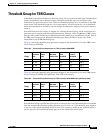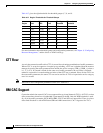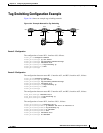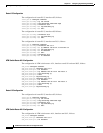
16-13
ATM Switch Router Software Configuration Guide
OL-7396-01
Chapter 16 Configuring Tag Switching and MPLS
Configuring Tag Switching CoS
Configuring Tag Switching CoS
Quality of service (QoS) allows ATM to meet the transmission quality and service availability of many
different types of data. The need for delay-sensitive data, such as voice, can be given a higher priority
than data that is not delay-sensitive, such as e-mail. The following service categories were created for
ATM Forum VCs to meet the transmission needs of various types of data: VBR-RT, VBR-NRT, ABR,
and UBR. See Chapter 9, “Configuring Resource Management,” for more information about the
standard ATM Forum implementation of QoS. This section describes tag switching class of service
(CoS).
Up to eight QoS classes (0 to 7) can be allocated to each physical interface port. Each port has an
independent logical rate scheduler (RS) and a weighted round-robin (WRR) scheduler. The RS
guarantees minimum bandwidth and has first priority on supplying an eligible cell for transmission.
Second priority is given to the service classes, which have been assigned relative weights that are based
on the ratio of the total leftover bandwidth. The service class relative weights are configurable so you
can change the priority of the default values. The VCs within a service class also have relative weights.
The service classes and VCs within a service class are scheduled by their relative weights.
With tag switching CoS, tag switching can dynamically set up to four tag virtual channels (TVCs) with
different service categories between a source and destination. TVCs do not share the same QoS classes
reserved for ATM Forum VCs (VBR-RT, VBR-NRT, ABR, and UBR). The following four new service
classes were created for TVCs: TBR_1 (WRR_1), TBR_2 (WRR_2), TBR_3 (WRR_3), and TBR_4
(WRR_4). These new service classes are called Tag Bit Rate (TBR) classes. TVCs and ATM Forum VCs
can only coexist on the same physical interface, but they operate in ships in the night (SIN) mode and
are unaware of each other.
TBR classes support only best-effort VCs (similar to the ATM Forum service category UBR); therefore,
there is no bandwidth guarantee from the RS, which is not used for TVCs. All of the TVCs fall into one
of the four TBR classes, each carrying a different default relative weight. The default values of the
relative weights for the four TBR classes are configurable, so you can change the priority of the default
values.
Table 16-1and Table 16-2 list the TBR classes and ATM Forum class mappings into the service classes
for physical ports.
Table 16-1 Service Class to Weight Mapping for Physical Ports
TBR Class Service Class Relative Weight
TBR_1 (WRR_1) 1 1
TBR_2 (WRR_2) 6 2
TBR_3 (WRR_3) 7 3
TBR_4 (WRR_4) 8 4
Table 16-2 ATM Forum Class Mapping for Physical Ports
ATM Forum Service
Category Service Class Relative Weight
CBR
1
28
VBR-RT 2 8
VBR-NRT 3 1



